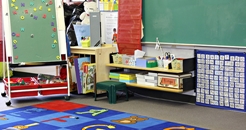 How different types of disadvantage impact England’s pre-school children
How different types of disadvantage impact England’s pre-school children
From a report by Nesta
Disadvantage gaps emerge early and persist. The type of disadvantage matters yet has remained relatively understudied.
For Nesta, Professor Edward Melhuish and Dr Julian Gardiner, Department of Education, University of Oxford, created a study providing new evidence on the relationship between different forms of early life disadvantage, children's cognitive and socio-emotional development and the impact of early childhood education and care using data from the Study of Early Education and Development (SEED), a longitudinal study of 5,642 children in England.
They found that childhood disadvantage has two major dimensions – economic disadvantage and home disadvantage.
Much previous research has demonstrated that children from disadvantaged backgrounds have poorer health and education outcomes than children from more advantaged backgrounds; this has generally been defined as economic disadvantage. However, children’s educational outcomes have also been shown to be influenced by aspects of the home environment such as the learning environment, household chaos and the quality of the parent/child relationship. A variety of parenting-related factors can be considered together as a single measure of ‘home disadvantage’.
Economic and home disadvantage have distinct relationships with later socio-emotional and cognitive outcomes.
Home disadvantage primarily affects socio-emotional outcomes, whereas economic disadvantage primarily influences cognitive outcomes.
Children experiencing both types of disadvantage have considerably poorer outcomes across all measures compared to non-disadvantaged children.
For children who experience home disadvantage, higher hours spent in nursery care (15-20 hours per week) are associated with better verbal ability outcomes at age five, when compared to a group who use fewer hours (up to 15 hours per week). This shows that early education and care can, to some extent, make up for less advantageous home environments.
For children who experience economic disadvantage, more hours in family and friend care is associated with better verbal ability, perhaps because the care offered is of high quality.
Non-disadvantaged children are most at risk of poor outcomes from long hours in group-based nursery care. This could be because non-disadvantaged children have good home environments and might receive more one-to-one interaction with an adult at home than in group care. Negative effects of nursery care on socio-emotional outcomes are only seen once usage goes above 30 hours (for economically disadvantaged children) or above 20 hours (non-disadvantaged children) per week.
For children experiencing economic disadvantage, or both home and economic disadvantage, more hours in childminder care are linked to negative socio-emotional outcomes. This likely reflects the poorer quality of childminder care to which economically disadvantaged families have access.
Disadvantaged children benefit much more from high quality early education and care than non-disadvantaged children, for whom variations in quality appear to be of little consequence.
For home disadvantaged children, higher quality early education and care is linked to improved non-verbal cognitive abilities.
For economically disadvantaged children, specific aspects of early education and care quality (those supporting ‘shared thinking’ and ‘early literacy’) are linked to improved non-verbal ability and better socio-emotional outcomes respectively.
For doubly disadvantaged children, higher quality early education and care relates to improved socio-emotional outcomes.
Higher quality was associated with a larger number of places, a narrower age range, more highly qualified managers and staff, a lower rate of staff turnover, a higher frequency of staff CPD and having a training plan and a training budget in place.
This set of results demonstrates that a wider perspective on disadvantage that includes consideration of the home environment may be useful in formulating policy for early childhood services. Once a more effective and consistent strategy to learn more about home environments is developed, initiatives to improve the home environment for children can be better targeted.
Since disadvantaged children benefit much more from high quality early education and care than non-disadvantaged children, supportive activities such as inspections and advice, and funding to support staff development, should be directed in particular to facilities that provide primarily for disadvantaged children.
Improvements in early education and care quality can be made through policy and legislative action. In view of the increased costs involved, changes could be targeted particularly for early education and care used by disadvantaged groups.
Read the full report here.
Retweet about this article:
From a report by Nesta, 02/10/2024